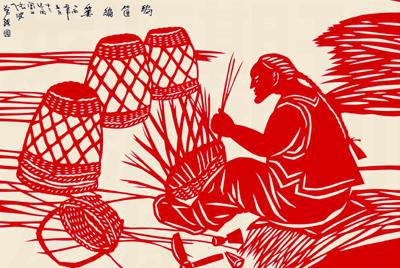Paper-Cutting Traces National Roots
2009-05-11WangGuang
Wang Guang

When the paper-cutting from Yiwulu Mountain was presented in an application for being named Chinese cultural heritage, most officials thought it a mission impossible. An official at the Ministry of Culture, the government agency in charge of selecting the countrys cultural heritage, point-blank dismissed the idea.
But the local government wouldnt budge an inch. It was highly confident, though the competition was fierce across the country. After many rounds of examinations and the final approval, the Yiwulu Mountain paper-cutting sat on the top of the list of the national cultural heritages in 2006, the first ever list issued by the Chinese government in a bid to safeguard and promote the countrys wide range of cultural heritage.
The success of the paper-cutting resulted from a research that lasted for 30 years in the Yiwulu Mountain. The mountain stretches in the western Liaoning Province in northeastern China. It sits in the area where Hongshan Culture prospered 5,000 to 8,000 years ago. Yiwulu is a name that goes back to very ancient times. Qu Yuan (340-278BC), the first known great Chinese poet, mentions Yiwulu Mountain in his longest poem “Li Sao” as a place of his ancestral roots.
Over the past thousands of years, Yiwulu Mountain has remained more or less secluded from the huge changes of the outside world. The soul-touching beauty of the paper-cutting artworks made by local folk artists there is largely attributed to the geographic seclusion of the people. They are minority Manchu people, some of whom founded the Qing Dynasty (1644-1911) and ruled China for hundreds of years.
Many Yiwulu paper-cutting artworks embody the primitive ideas preserved well in the mountain area. Some designs show the warship of natural gods, a religious practice in primitive societies. The sky-reaching tree, the tree of life, and the mountain god can be seen in the paper cuttings. Some designs show the worship of reproduction: a goddess has breasts as huge as mountains that feed everything in the world. Totems such as willows, foxes and cows can also been seen. Moreover, the primitive deities are depicted in a very unique vocabulary of paper-cutting art. Unlike paper-cutting artworks seen in the rest parts of China, the paper-cutting artworks at Yiwulu Mountain feature no complicated cutting techniques and highlight no finest details. Nor do they seek accuracy and sophistication in creating images. These paper-cutting works present a style of majesty and simplicity and an ancient charm.
Experts comment that the paper-cuttings are a history of images and symbols kept by the folk artists over a period of the past 8,000 years. These are more than paper-cutting artworks. They constitute valuable records of a people for further researches in history, philosophy, archaeology, ethnology, sociology, art theory, and cultural anthropology.
No wonder the Yiwulu Mountain paper-cuttings immediately caught the attention of the world when they were first displayed. In 2004, the paper-cuttings made their world debut at the Beijing Folk Lifestyles Museum. Experts of Japan and Korea heard of the unique paper-cuttings and rushed over to take a look. They loved the artworks and could not tear themselves away. At the 7th Conference of International Society for Shamanistic Research held in Changchun in August, 2004, ISSR president Mihaly Hoppal was delighted to see the paper-cuttings and proposed to have a Yiwulu Mountain paper-cutting exhibition in Hungary. Feng Jicai, president of the China Folk Artists Association, wowed at the sight of the paper-cuttings. His essay on the conference, published in Chinas most respectful literary bimonthly Harvest, spoke highly of the paper-cuttings. Four paper-cutting artworks came out with the essay in the bimonthly.

The folk artists are grass-roots rural people who not only have absorbed the unique local cultural heritages and various ethnic influences but also have stayed free of arguably polluting values and concepts from the outside world.
Wang Xiuxia began to learn the Manchu-ethnic paper-cutting as a child. She married into a family in the village of Sandaogou in Yiwulu Mountain. The village used to be home to Qidan ethnic people who guarded the mausoleums of the Liao Dynasty (907-1125) in northern China. Her mother-in-law was a famous shaman in the mountain. The paper-cutting artworks created by Wang Xiuxia depict a shamanistic world which appears grotesque and crazy. Her art is viewed as the best expressions of shamanism in this part of the world.
“Willow Tree Mama” is a common subject in Yiwulu Mountain paper-cuttings. Different local artists have different visions. The “Willow Tree Mama” created by Zhang Xirong now 91, a woman who lived as a child in a village of Mongolians, describes how the goddess gives birth to the universe in this order: the sky with floating clouds appears first, followed by the earth where deer runs, and then the water in which fish swim in pleasure. Zhang Xirong experienced a lot of ups and downs until she was 70 when she finally got out of the anonymous world and became famed for her paper-cutting artworks. Literally she got out of the anonymous world, for at 70 she became Zhang Xirong for the first time in her life. □
